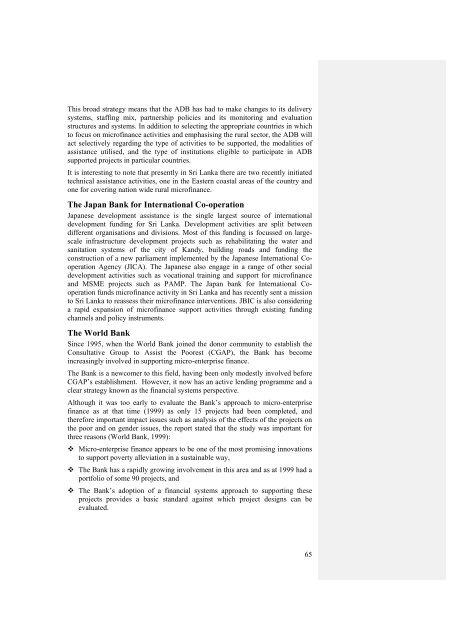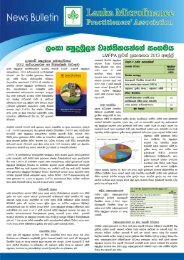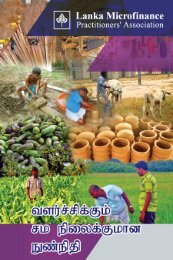National Microfinance Study of Sri Lanka: Survey of Practices and ...
National Microfinance Study of Sri Lanka: Survey of Practices and ...
National Microfinance Study of Sri Lanka: Survey of Practices and ...
You also want an ePaper? Increase the reach of your titles
YUMPU automatically turns print PDFs into web optimized ePapers that Google loves.
This broad strategy means that the ADB has had to make changes to its delivery<br />
systems, staffing mix, partnership policies <strong>and</strong> its monitoring <strong>and</strong> evaluation<br />
structures <strong>and</strong> systems. In addition to selecting the appropriate countries in which<br />
to focus on micr<strong>of</strong>inance activities <strong>and</strong> emphasising the rural sector, the ADB will<br />
act selectively regarding the type <strong>of</strong> activities to be supported, the modalities <strong>of</strong><br />
assistance utilised, <strong>and</strong> the type <strong>of</strong> institutions eligible to participate in ADB<br />
supported projects in particular countries.<br />
It is interesting to note that presently in <strong>Sri</strong> <strong>Lanka</strong> there are two recently initiated<br />
technical assistance activities, one in the Eastern coastal areas <strong>of</strong> the country <strong>and</strong><br />
one for covering nation wide rural micr<strong>of</strong>inance.<br />
The Japan Bank for International Co-operation<br />
Japanese development assistance is the single largest source <strong>of</strong> international<br />
development funding for <strong>Sri</strong> <strong>Lanka</strong>. Development activities are split between<br />
different organisations <strong>and</strong> divisions. Most <strong>of</strong> this funding is focussed on largescale<br />
infrastructure development projects such as rehabilitating the water <strong>and</strong><br />
sanitation systems <strong>of</strong> the city <strong>of</strong> K<strong>and</strong>y, building roads <strong>and</strong> funding the<br />
construction <strong>of</strong> a new parliament implemented by the Japanese International Cooperation<br />
Agency (JICA). The Japanese also engage in a range <strong>of</strong> other social<br />
development activities such as vocational training <strong>and</strong> support for micr<strong>of</strong>inance<br />
<strong>and</strong> MSME projects such as PAMP. The Japan bank for International Cooperation<br />
funds micr<strong>of</strong>inance activity in <strong>Sri</strong> <strong>Lanka</strong> <strong>and</strong> has recently sent a mission<br />
to <strong>Sri</strong> <strong>Lanka</strong> to reassess their micr<strong>of</strong>inance interventions. JBIC is also considering<br />
a rapid expansion <strong>of</strong> micr<strong>of</strong>inance support activities through existing funding<br />
channels <strong>and</strong> policy instruments.<br />
The World Bank<br />
Since 1995, when the World Bank joined the donor community to establish the<br />
Consultative Group to Assist the Poorest (CGAP), the Bank has become<br />
increasingly involved in supporting micro-enterprise finance.<br />
The Bank is a newcomer to this field, having been only modestly involved before<br />
CGAP’s establishment. However, it now has an active lending programme <strong>and</strong> a<br />
clear strategy known as the financial systems perspective.<br />
Although it was too early to evaluate the Bank’s approach to micro-enterprise<br />
finance as at that time (1999) as only 15 projects had been completed, <strong>and</strong><br />
therefore important impact issues such as analysis <strong>of</strong> the effects <strong>of</strong> the projects on<br />
the poor <strong>and</strong> on gender issues, the report stated that the study was important for<br />
three reasons (World Bank, 1999):<br />
Micro-enterprise finance appears to be one <strong>of</strong> the most promising innovations<br />
to support poverty alleviation in a sustainable way,<br />
The Bank has a rapidly growing involvement in this area <strong>and</strong> as at 1999 had a<br />
portfolio <strong>of</strong> some 90 projects, <strong>and</strong><br />
The Bank’s adoption <strong>of</strong> a financial systems approach to supporting these<br />
projects provides a basic st<strong>and</strong>ard against which project designs can be<br />
evaluated.<br />
65
















